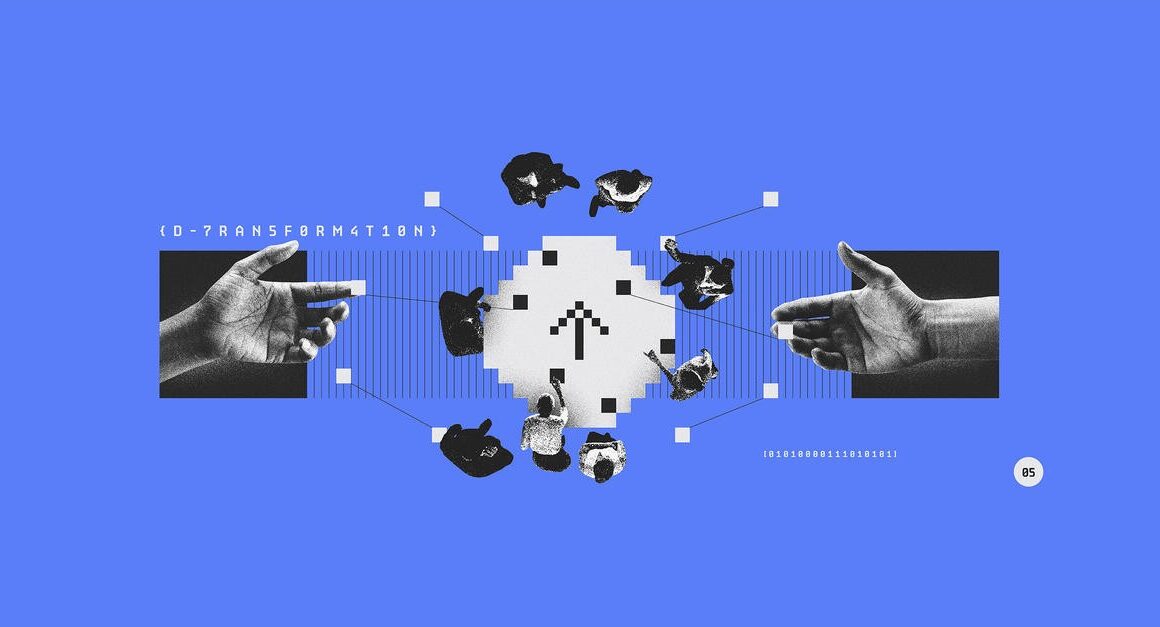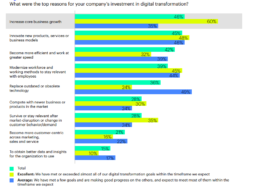MIT Sloan — Management School
by Sara Brown
May 27, 2021
Citations: Kristine Dery; Hal Gregersen,
When it comes to digital transformation, most businesses focus on technology and new tools as they vie to keep up and find new ways to appeal to customers.
But focusing too much on the technology and tasks that come with digital transformation leaves out another vital component to successful transitions — a company’s employees, who need to be able to use new technology and feel comfortable and supported in new roles.
The stakes are high, according to Kristine Dery, a research scientist with the MIT Center for Information Systems Research, who studies employee experience.
Companies that invest in the right experience for their people, and make sure they are ready for the future, tend to outperform their competitors.
- On average they deliver 19% more growth in revenue than their competitors,
- and have 15% more profit.
These companies are also more innovative, better at cross-selling, and deliver a significantly better customer experience, Dery said.
“There’s a lot of opportunity here,
and companies are leaving a lot of value on the cutting room floor
by not investing in the experience of their employees,”
she said.
Companies should aim to make their employees empowered problem solvers, Dery said, by creating a supportive environment of continual and rapid learning where they can leverage technologies to solve unpredictable problems.
These employees need to have confidence to solve problems, and the skills to work effectively in a digital world.
Leaders also need to consciously address transitions themselves to help their employees adjust to shifting roles, acquire new capabilities, and manage emotional energy to navigate change and uncertainty, according to Hal Gregersen, a senior lecturer in leadership and innovation at MIT Sloan.
“We make enormous investments into the technical side of digital transitions,
and comparatively minimal investment in actually helping individuals navigate the challenging transition from here to there,” Gregersen said.
Here are three ways to look out for employees during times of digital transformation.
- Manage the balance between technology and employee skills
- Accelerate employee adjustment to new roles, not just new tasks
- Have the right leadership in place — and make sure to lead by example
1.Manage the balance between technology and employee skills
Employees thrive when they have the right technology, the knowledge to use that technology, and the freedom to learn, experiment, and improve things, Dery said. A good way to think about this is freedom within a framework — employers create the framework, or decision rights, and beyond that employees are able to redefine and redesign work to get the best results.
To work effectively in a digital world, employees need to understand more than just how to use the technologies provided for them in the workplace, Dery said. They also need the skills and the freedom to make changes to improve workflow or deliver the right outcomes to customers. For example, a component designed to give employees secure access to one part of the business could be reapplied to other parts of the business or used to grant smoother access to outside visitors.
Companies are leaving a lot of value on the cutting room floor by not investing in the experience of their employees.
Focusing too much on acquiring the right technologies without paying attention to whether employees have skills and are empowered to leverage value from them can lead to situations in which companies find themselves hostage to technology, Dery said. Companies need to avoid the trap of investing too much in the equipping of people to do their work without the necessary training to enable them to use those tools effectively, she said.
Yet focusing too much on building high levels of digital skill without being able to implement and scale innovation is equally problematic. Without the digital technologies to support their new ideas, highly competent people tend to apply workarounds such as pulling technologies from the cloud to add value. This results in either pockets of digital innovation that can’t be scaled, or worse, much-needed digital talent becomes frustrated at the lack of technology to support their ideas, and leaves.
It’s a difficult balance, Dery said, and requires leadership to focus on both digitizing work and digital fitness of its employees.
CISR research has mapped different pathways companies take toward digital transformation, based on how organizations change customer experience and operational efficiency.
Companies that focus first and foremost on the operational backbone — technology matched with employee skills — tend to create better experiences for their employees.
On average, digital transformation significantly impacts 67% of employees, Dery said, and reducing the complexity of employee-facing technologies better equips employees to add value and determines skill-building priorities.
A focus on offering exciting developments to customers often comes at the expense of employees, Dery said. This can lead to a “culture of heroics” where employees have to make things happen for customers without being well supported.
“The allure of being able to constantly generate new innovation for the customer often leads to less focus on the employee,” she said.
“It’s a pathway of addiction:
- It creates a lot of excitement in the market, boards love it, [and]
- everyone gets very excited by all these new innovations at the front end.
- [But] they are less concerned and become even less willing to open the black box of all the problems that are facing employees.”
2. Accelerate employee adjustment to new roles, not just new tasks
Gregersen, who co-authored “ It Starts With One: Changing Individuals Changes Organizations,” and teaches MIT Sloan Executive Education courses about leading successful transitions, said leaders tend to treat adopting digital tools as an end, when they should be considered means to an end.
“Many managers are biased towards the belief that if we change the system, structure, and process, individuals will magically do what we’re asking them to do,” Gregersen said.
This includes emphasis on how employee tasks change, but little attention toward how employees will experience a change in their workplace roles and the emotional energy it takes to navigate that transition.
But neglecting any one of those areas makes it unlikely that employees will expertly use technology to make the gains companies want.
Adjusting to transitions requires asking questions in three areas, Gregersen said:
- “What new capabilities (skills, mindsets) must be acquired to master the new work to be done?”
Gregersen said his research with Roger Lehman, a senior lecturer at MIT Sloan, shows that an exclusive focus on learning new tasks is a knee-jerk response for most leaders.
“We get really caught up in the ‘Don’t just stand there, do something’ logic.
And when that happens, we start doing all these new things and fail to grasp the broader implications,” he said.
When tasks to be done are changing and significant, employee roles in the organization are also changing.
While learning new tasks is important — for example, adjusting to working during the pandemic meant learning to how to use videoconferencing tools — it isn’t the only thing to tackle in transitions.
2. “How are roles changing?”
Adjusting to new roles during digital disruption can be similar to adjusting to work and life in a new culture, Gregersen said.
There is often a honeymoon period, followed by culture shock when people realize how much they don’t know, then adjustment, and then mastery.
Accurately assessing and negotiating role changes is often overlooked, Gregersen said. “Most leaders excel at thinking, ‘Oh, here are the tasks to be done,’ but they often don’t step back to consider how specific roles are changing and what that means for people experiencing a significant identity shift at work,” he said.
3. “How successfully is everyone acknowledging and channeling emotional energy, every point of the way?”
When roles shift, identities change, and people have to acquire challenging new capabilities, they will face emotional ups and downs.
People who used to follow up with customers, for example, might be lost if an automated system takes over that task, and question their work identity. Leaders need to create psychologically safe spaces for people to express how they are feeling and find ways to work through their feelings.
Emotional engagement can’t be overlooked, Gregersen said, because even if progress is made in other areas — adjusting roles and acquiring capabilities — failing to manage emotional energy well can send a digital transition backwards.
“Any major change, or even minor, involves loss. Grief is our human response to loss. So when navigating any transition, we’re losing something to get something,” he said.
3.Have the right leadership in place — and make sure to lead by example
Within the organization, who should be tasked with looking out for employees and making sure they are given what they need to succeed during the transition? Companies have approached this in two ways, Dery said.
A more traditional option is appointing a senior leader with skills in both technology and business, someone like a chief employee officer or chief employee experience officer.
“That can be very effective, particularly if you get the right person in that role,” she said.
But people with that combination of skills can be hard to find.
Another option is “two in a box” style leadership, Dery said, which would bring together a technology person and a business person to jointly fill the role.
The two leaders would have to work toward the same objectives, with joint key performance indicators, rather than each leader having distinct goals.
These leaders are the ones who will continually steer teams that work within their areas toward overall goals for the organization, Dery said, as well as manage talent.
The change in thinking can be difficult, especially for large, established organizations, Dery said. But it’s important for leaders to set the right tone.
“I can’t stress enough that one of the big roles of those leaders is to create a safe, supporting environment where people are able to learn,” she said. “They can’t [learn] if they’re constantly feeling like their job is in jeopardy or their reputation is in some way vulnerable.”
Gregersen said leaders of changing organizations need to first reflect on and manage their own transitions to model what they are expecting others to do.
For example, auditing their own past responses to significant transitions in work and life often reveals a pattern of action that continues to guide how they navigate change, he said.
Another tool for tackling tough transitions is the question burst — a method created by Gregersen where individuals or teams brainstorm nothing but questions about a challenge to kickstart progress.
Leaders should also remember that change is ongoing.
“This is an iterative process that companies have to keep going through,” Dery said. “It’s not an end state that you reach … you have an ongoing process of ensuring that your people are constantly able to thrive in this world of digital.”
About the author
Sara Brown, News Writer
Sara writes about management issues affecting global business leaders, with an emphasis on management science. Areas of interest include artificial intelligence, the digital economy, marketing, operations management, platforms, system dynamics, and supply chain.
Originally published at https://mitsloan.mit.edu on June 30, 2021.











